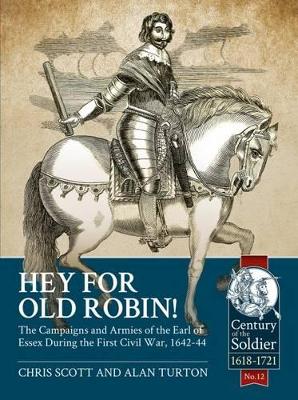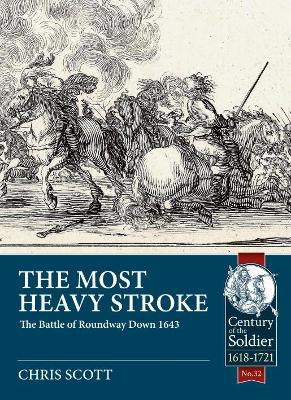Century of the Soldier
2 total works
Hey For Old Robin! was the cry of the Earl of Essex's army during the First Civil War as, contrary to modern popular belief, Robert Devereux was well-liked by the men he led. This book fills a gap in the literature of the Civil Wars, taking up the challenge to write a new history of Essex and his Army and examining the often-repeated view that he was a cautious dullard with little military skill. The two authors Christopher Scott and Alan Turton, both well known published military historians, present a more balanced view of Parliament's first Lord General, bringing him out of the shadow of Cromwell. In doing so they are not afraid to bite the bullet of period and modern criticism of Essex as a strategist and tactician, as well as his reported failings as a man.
Based on primary research, including site visits to scenes of his triumphs and disasters, they trace the story of the early campaigns, beginning with Edgehill, then Brentford and Turnham Green, the relief of Gloucester and the retreat to Newbury, the Siege of Reading, the Thames Valley Campaign, the disaster of Lostwithiel and the rebuilding of the army for Second Newbury. Whilst they leave the detailed examination of the various battles fought by Essex and his men to more specialist books, they tell the story of each of the campaigns and share their thoughts on Essex's problems and his decisions and actions. They also examine how the armies were constituted, officered, recruited and maintained, as well as its reductions and transfers.
In separate chapters they describe Essex's Foot, the Horse, the Dragoons, The Artillery and The Train, dealing with what the army wore, what it was paid, what weapons it used, the flags it carried and how it was organised, operated and fought. All this is set within a sound understanding and appreciation of the background of the seventeenth century and Essex's place in the socio-political zeitgeist as well as period military thinking and practice. Illustrated with a wealth of seldom-seen contemporary engravings of Essex's officers and friends and newly commissioned maps, as well as uniform and cornets & colours plates, this work is of great use to anyone with an interest in our civil wars including academics, local historians, re-enactors and wargamers.
Based on primary research, including site visits to scenes of his triumphs and disasters, they trace the story of the early campaigns, beginning with Edgehill, then Brentford and Turnham Green, the relief of Gloucester and the retreat to Newbury, the Siege of Reading, the Thames Valley Campaign, the disaster of Lostwithiel and the rebuilding of the army for Second Newbury. Whilst they leave the detailed examination of the various battles fought by Essex and his men to more specialist books, they tell the story of each of the campaigns and share their thoughts on Essex's problems and his decisions and actions. They also examine how the armies were constituted, officered, recruited and maintained, as well as its reductions and transfers.
In separate chapters they describe Essex's Foot, the Horse, the Dragoons, The Artillery and The Train, dealing with what the army wore, what it was paid, what weapons it used, the flags it carried and how it was organised, operated and fought. All this is set within a sound understanding and appreciation of the background of the seventeenth century and Essex's place in the socio-political zeitgeist as well as period military thinking and practice. Illustrated with a wealth of seldom-seen contemporary engravings of Essex's officers and friends and newly commissioned maps, as well as uniform and cornets & colours plates, this work is of great use to anyone with an interest in our civil wars including academics, local historians, re-enactors and wargamers.
Sir William Waller called his defeat at the Battle of Roundway Down, the most heavy stroke that ever befell him. He also said it turned victory into mourning and glory into shame. Indeed his loss in July 1643 was both dramatic and unexpected but what exactly happened has posed questions to historians for many generations. For years the same old solutions as to why Waller's combined-arms army was overcome by a cavalry force of less than half its numbers have been discussed, but with little variation. They all appear to hail the experience of the vaunted Oxford Horse, the idea that the parliamentarian Horse began their fights stationary, the personal skills of Wilmot and Byron over those of Haselrig and Hungerford, and the cowardice of the parliamentarian Western Horse. These factors are probably correct in some measure, but this volume says there are two more, perhaps even greater reasons for the collapse of Waller's mounted troops. The text describes how the tactics of the day put Waller's cavalry at a decided disadvantage and that Wilmot having understood the lessons of Edgehill was able to make full use of what he saw. The book also argues a case that perhaps the ostlers and grooms of Oxfordshire contributed more to the royalist victory than has hitherto been acknowledged. The Most Heavy Stroke is full of new information and new ideas, and offers a new interpretation of what occurred and why.
Not only how it happened, but where the fighting actually took place has also over the years brought several interpretations to the fore. However, many previous writers seem to ignore several witnesses whose testimonies render their own basic deployment premise somewhat flawed. The Most Heavy Stroke combines what accounts say of movements and eye-witness terrain descriptions with knowledge of period practice in a deeper study of both battle and battlefield than has been hitherto undertaken, turning agreed previous positions of both armies on their head.
The Most Heavy Stroke combines new thinking on the battle with recent research on which units took part in the fighting, and what they wore and the flags they carried, even though it acknowledges the paucity of current information.
Not only how it happened, but where the fighting actually took place has also over the years brought several interpretations to the fore. However, many previous writers seem to ignore several witnesses whose testimonies render their own basic deployment premise somewhat flawed. The Most Heavy Stroke combines what accounts say of movements and eye-witness terrain descriptions with knowledge of period practice in a deeper study of both battle and battlefield than has been hitherto undertaken, turning agreed previous positions of both armies on their head.
The Most Heavy Stroke combines new thinking on the battle with recent research on which units took part in the fighting, and what they wore and the flags they carried, even though it acknowledges the paucity of current information.

